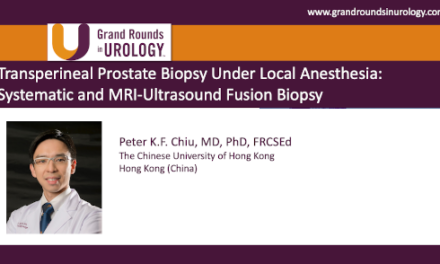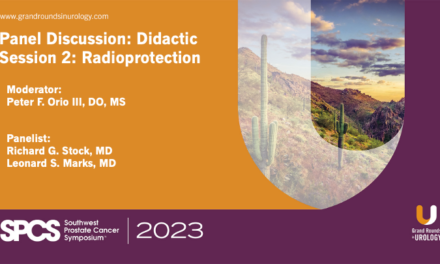
PCa Commentary | Volume 188 – April 2024
Posted by Edward Weber | April 2024
Prostate Cancer Heterogeneity — Clinical Consequences and Therapeutic Relevance.
This content is available free to the GRU Community. Login or create an account to view it.
Prostate cancer is heterogeneous throughout – within the prostate are divergent clones of varying malignant potential vying for escape. Within and among metastatic sites heterogeneity reigns. This complex biology presents diagnostic challenges and complicates management decisions. This Commentary reviews a seminal article which comprehensively researched this issue and provides clinical insight.
“Reversible epigenetic alterations mediate PSMA expression heterogeneity in advanced metastatic prostate cancer,” Sayer, Haffner and 22 colleagues, JCI insight, Feb 2023.
The key to their findings is the powerful tool of “rapid autopsy” wherein the prostate and multiple metastases sites are extensively biopsied directly after a patient’s death. Although PSMA is extensively expressed in localize cancer, “imaging studies of metastatic castration-resistant prostate cancer have demonstrated that up to 30% of patients have PSMA-negative tumors.” Of 52 men (339 sites evaluated) with metastatic disease 25% had no detectable PSMA at any site. (Prostate Specific Membrane Antigen is the cell surface protein found in varying intensity on prostate cells). 44% of men “showed heterogeneous PSMA expression across individual metastases”. A single lesion might have both high and low PSMA expressing cells with “33 (63%) cases harboring at least one PSMA negative site.” Some cells lacking PSMA expression exhibited a biomarker for neuroendocrine transformation (NE). A small percentage of cells (7%) lacked expression of both PSMA and neuroendocrine markers. This heterogeneity limits the diagnostic effectiveness of PSMA PET scans in imaging the totality of a patient’s metastatic disease burden and has consequences relating to radioligand targeting of PSMA with, i.e., 177-Lutetium-PSMA-617.
Additional complexity regarding PSMA expression was seen: “Notably, we observed focal PSMA staining of the tumor-associated vasculature in tumors lacking PSMA expression in tumor cells.”
The PSMA negative tumors inversely expressed an alternative surface antigen, MUC1 (aka CEACAM5), a neuroendocrine marker whose function is to suppress a cell’s differentiation toward maturity and promote tumor growth. Varying PSMA expression was seen in different organs with lower expression in liver lesions, higher levels in adrenal glands, as compared to middling levels in the prostate and bone metastases suggesting “an interplay between the tumor microenvironment of metastatic sites and PSMA expression.”
The Sayer research discovered a therapeutically relevant relationship: “Epigenetic therapies can restore and augment PSMA expression.” They noted that a suppressive tag (epigenetic methylation) on DNA at portions of the FOLH1 gene suppressed PSMA expression and that the available drug, vorinostat (Zolinza), a histone deacetylase inhibitor, can remove this tag and partially restore PSMA expression. The effect of this agent in reversing PSMA suppression was confirmed in experiments in mice. Taken all together, the combined use of this drug with radioligand targeting of PSMA with, i.e., 177-Lu-PSMA-617 (Pluvicto), might increase the effectiveness of this regimen. The mixture of PSMA and CEACAM5 among metastases suggested a regimen of “co-targeting” both antigens with appropriate radioligands.
PCa Commentary
What are the major take-away points from this elegant research?
- Heterogeneity of clones within the prostate and among metastatic sites dilute the accuracy of single site biopsies to capture the dominant genomic character of the cancer on which risk assessment and treatment selection are made. Assaying circulating free tumor DNA or sequencing pooled biopsies can provide broader coverage.
- Response to radioligand therapy with 177-Lu-PSMA-617 (Pluvicto) is proportional to the intensity of PSMA expression in the prostate and metastatic sites, as imaged by PET scans with Pylarify and Ga-68-PSMA-11. A substantial number of metastatic sites show weak PSMA expression and 25% show no PSMA expression and would be expected to respond poorly or not at all to radioligand therapy.
- In the Vision trial of 177-Lu-PSMA-617 in men with advanced metastatic prostate cancer only approximately 50% of men showed a >50% decline in PSA, an outcome explained by the heterogeneity of PSMA expression among metastases. The extent of heterogeneity of PSMA expression at earlier stages of disease has not been reported.
- The extent of PSMA expression in metastatic lesions is inversely proportional to the expression of markers for neuroendocrine transformation, CEACAM5 / MUC1, suggesting applicability of co-targeting of PSMA and CEACAM5 / MUC1, when radioligands for the latter are effectively developed. MUC1 can be targeted with CAR-T and antibody-drug conjugate therapies.
- Epigenetically silenced PSMA expression at the FOLH1 gene can be reversed with vorinostat, a histone deacetylase inhibitor, suggesting that the effectiveness of radioligand targeting of PSMA could be enhanced by combining radioligand therapy with vorinostat.
BOTTOM LINE:
Advanced research documenting the heterogeneity of PSMA and CEACAM5 expression in metastatic prostate cancer carries significant implications regarding the diagnostic and therapeutic effectiveness of PSMA targeting in advanced disease. A regimen for restoring decreased PSMA expression is presented.
Please also visit https://prostatecancerfree.org/prostate-cancer-news for a selection of past issues of the PCa Commentary covering a variety of topics.
“We appreciate the unfailing assistance of the librarians at Providence/Swedish.”
ABOUT THE AUTHOR
Edward Weber, MD, is a retired medical oncologist living in Seattle, Washington. He was born and raised in a suburb of Reading, Pennsylvania. After graduating from Princeton University in 1956 with a BA in History, Dr. Weber attended medical school at the University of Pennsylvania. His internship training took place at the University of Vermont in Burlington.
A tour of service as a Naval Flight Surgeon positioned him on Whidbey Island, Washington, and this introduction to the Pacific Northwest ultimately proved irresistible. Following naval service, he received postgraduate training in internal medicine in Philadelphia at the Pennsylvania Hospital and then pursued a fellowship in hematology and oncology at the University of Washington.
His career in medical oncology was at the Tumor Institute of the Swedish Hospital in Seattle where his practice focused largely on the treatment of patients experiencing lung, breast, colon, and genitourinary cancer and malignant lymphoma.
Toward the end of his career, he developed a particular concentration on the treatment of prostate cancer. Since retirement in 2002, he has authored the PCa Commentary, published by the Prostate Cancer Treatment Research Foundation, an analysis of new developments in the prostate cancer field with essays discussing and evaluating treatment management options in this disease. He is a regular speaker at various prostate cancer support groups around Seattle.




